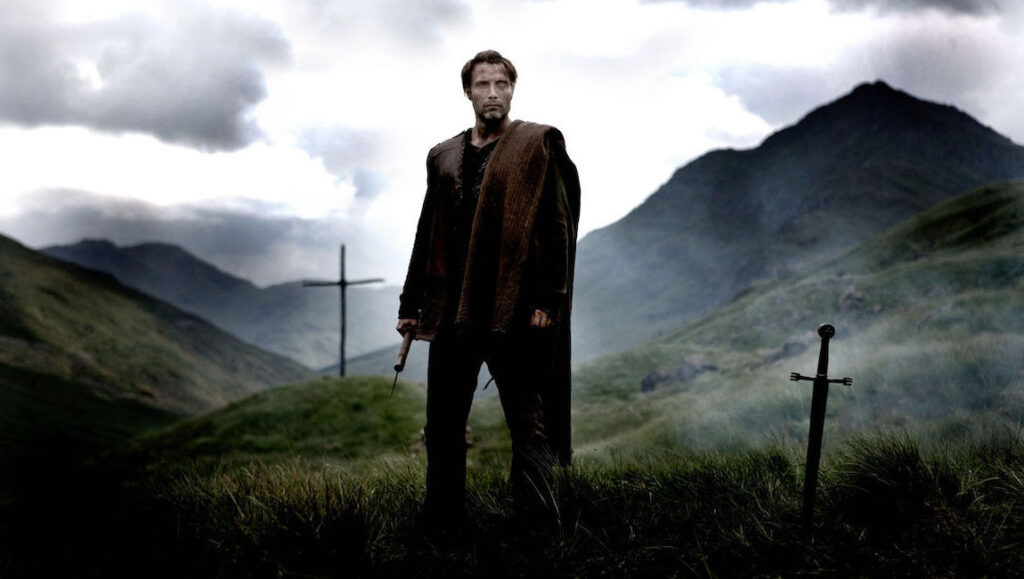Like a vengeful cornered beast, Nicolas Winding Refn’s Valhalla Rising exhibits a desperate ferociousness during even its most lyrical moments. Set in 1000 AD amidst a relentless Christian crusade against Norse heathens, Valhalla Rising focuses on silent warrior One Eye (Mads Mikkelsen), a slave-cum-gladiator who methodically dispatches his competition with brutal precision. During these scattered fits of violence, skull-cracking booms echo off the foggy highlands that shroud the entire narrative in a mystical haze. Refn juxtaposes the silent beauty of rocky mountainsides, lush flora, and withering winds with the palpable rage of hand-to-hand combat. Instinct rules this roost, and Refn largely avoids dialogue in favor of stark glances, kinetic movement, and relentless violence. Language does not come in the form of words, but pummeling fists and savage swipes of an axe. But Valhalla Rising belongs on the same family as Terrence Malick’s The New World rather than a period epic like Ridley Scott’s Gladiator; it instills a vivid sense of place through layered sound design and long camera takes. Refn sets the viewer on a singular trek, where momentum only exists if nature allows it.
Following Valhalla Rising’s brutal opening, which finds One Eye as a prizefighting showman for battling warlords, the narrative only becomes more surreal and disjointed. One Eye escapes enslavement, befriends a nameless young Boy (Maarten Stevenson), and joins up with a group of Vikings/Christian fundamentalists, his unforgiving environment informing his extreme actions. Refn contrasts the Christians’ conversations with One Eye’s enigmatic silence. Temporality moves to the background, and ideology is filtered through a bloody and textured lens of the extreme wide-angle. Unlike in Bronson, Refn’s previous film, which matches its protagonist’s warped sense of reality with kinetic manipulations of the timeline, the director celebrates a quiet menace in every frame of Valhalla Rising. After an endless, palpable fog pushes their boat to the edges of the earth, One-Eye and his group find themselves ashore in a new land (probably America), and the rhythms of the space begin to overwhelm their senses. The Christians slowly lose their minds, the limitlessness of the sprawling locale eroding their fervent beliefs. One-Eye and the Boy watch as the act of discovery reveals terrible consequences rooted in greed, deceit, and faith-based sacrifice. The film descends into a languishing void of water, blood, greenery, and mud, and these textures flood the visual field with ravishing force.
Valhalla Rising embraces this devastating uncertainty within familiar genre mythology, punishing those who attempt to control it by hurling arrows and spears out of every corner. We never see the natives, but it seems the Earth itself is relentlessly lobbing these weapons of mass destruction at One-Eye and his brood. As if expecting horror to leap from any angle, Refn tones down his visual aesthetic, creating a moody, almost Herzogian vision of historical revisionism that sees terror in actions and reactions just out of sight. One-Eye practically grows roots into the jaded rock face in the final moments, at peace with his destiny as a focal point for savage heroism. All visceral force, Valhalla Rising is a broadsword of cinematic prowess directly tied to the power of a dynamic mise-en-scene, a text brilliantly in tune with the tension between character and location. It’s a film that speaks in tongues, but communicates on an elemental level. Like his lead character, Refn favors an ambiguous ideological focus, an epic construction of good and evil seen through the hallucinatory guise of a violent and noble prophet. Pushed to the brink, One Eye finds his strength in watching others wilt under the pressure of contradiction. In his world, the art of war and of silence are kindred spirits, and only a select few have the skill to successfully wield them both.


Comments are closed.